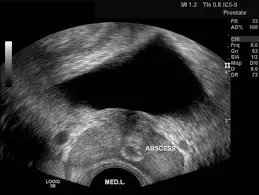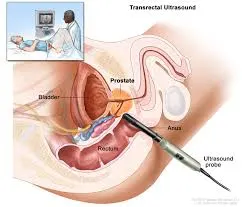How to interpret transrectal ultrasounds: 3 key methods
Transrectal ultrasound (TRUS) is an imaging technique that uses sound waves to create images of the prostate and surrounding tissues. This guide explains what a TRUS can reveal, why it's used, and how to understand its findings.
What is a Transrectal Ultrasound?
A TRUS is a minimally invasive imaging test where a small probe is inserted into the rectum to produce real-time images of the prostate, seminal vesicles, and nearby structures. Unlike X-rays, TRUS uses sound waves, making it safe and painless. Let's explore the details of this technique.

What Can Transrectal Ultrasound Show?
- Prostate Imaging: Detailed views of the prostate gland, including size, shape, and any abnormalities.
- Seminal Vesicle Evaluation: Assessment of the seminal vesicles for issues like cysts or inflammation.
- Detection of Prostate Cancer: Helps in identifying suspicious areas that may require further investigation, like biopsies.
- Guidance for Biopsies: TRUS is commonly used to guide prostate biopsies, ensuring accurate sample collection.
- Monitoring Prostate Health: Useful for tracking the progression of prostate conditions and the effectiveness of treatments.
Why Might You Need a Transrectal Ultrasound?
- Elevated PSA Levels: When blood tests show high levels of prostate-specific antigen (PSA), TRUS can help to understand the reason for this.
- Abnormal Digital Rectal Exam (DRE): To investigate any abnormalities felt during a physical exam of the prostate.
- Urinary Symptoms: In cases of urinary issues or suspected prostate enlargement.
- Prostate Cancer Monitoring: Follow up and staging in patients with diagnosed prostate cancer.
- Infertility Evaluation: Assessment of the seminal vesicles as part of an infertility workup.
How is a Transrectal Ultrasound Performed?
The TRUS procedure is relatively straightforward and typically performed in a doctor's office or clinic. Here's a step-by-step overview:
- Preparation: You may be asked to empty your bladder before the procedure. In some cases, an enema may be recommended.
- Positioning: You'll be asked to lie on your side, usually with your knees bent towards your chest.
- Probe Insertion: A small, lubricated ultrasound probe is gently inserted into your rectum. The probe is about the size of a finger.
- Imaging: The probe emits sound waves to create images of the prostate gland and surrounding tissues on a monitor.
- Procedure Completion: Once the images have been obtained, the probe is carefully removed. The procedure typically takes between 10 to 30 minutes.

The procedure is usually well-tolerated, and most patients experience minimal discomfort. You can typically resume normal activities immediately after the TRUS.
How to Interpret Transrectal Ultrasound Results
Understanding your TRUS results is crucial for managing your health. Here are some common methods for interpreting the results.
1. Utilizing X-ray Interpreter
X-ray Interpreter now analyzes ultrasound images with its AI-driven analysis. Here's how to use it:
- Registration: Sign up on X-ray Interpreter to use our AI for TRUS analysis.
- Uploading Ultrasounds: Upload your transrectal ultrasound images.
- Reviewing Interpretation: Receive the AI-generated interpretation, including a report.
- Consultation: Always consult with your physician for comprehensive diagnosis.
Check our get started guide for more details.
2. Using ChatGPT Plus
ChatGPT Plus, with its advanced GPT-4V model, can assist in analyzing ultrasound images:
- Subscription: Subscribe to ChatGPT Plus for advanced analysis.
- Uploading Ultrasounds: Upload your ultrasound images on the OpenAI platform.
- Request Analysis: Ask the AI to interpret your ultrasound images and give you a report.
- Review and Validate: Review the results and confirm its accuracy with a healthcare professional.
Find out more in our blog on using ChatGPT Plus for medical image interpretation.
Alternatively, as several other AI models with vision capabilities emerge, you can also try other models, such as Grok by xAI, Claude by Anthropic, Gemini by Google Deepmind.
3. Understanding the Basics Yourself
While not a replacement for medical professionals, knowing some basics can help you comprehend the results and ask the right questions.
- Learn Anatomy: Familiarize yourself with the basic anatomy of the prostate and surrounding structures.
- Read Simple Guides: Many online resources help you understand common TRUS findings.
- Ask Questions: Note any unfamiliar terms and ask your healthcare provider during your follow up.
- Seek Expert Guidance: Always validate your understanding with a medical professional.
Comparing the Different Approaches
Let's compare the different methods for interpreting transrectal ultrasounds:
| Criteria | X-ray Interpreter | ChatGPT Plus | Self-Reading |
|---|---|---|---|
| Accuracy | High (AI-based)1 | High (AI-based)1 | Varies (Skill-dependent) |
| Ease of Use | Easy | Moderate | Challenging |
| Cost | Starting from $2.50 per image | $20 per month | Free (excluding educational costs) |
| Time Efficiency | Fast | Moderate to Fast | Slow to Moderate |
| Learning Curve | Low | Low to Moderate | High |
| Additional Resources | Provided | Partially Provided (through OpenAI) | Self-sourced |
Each method has its own pros and cons. AI-driven options offer quick and precise results, while basic knowledge aids in better patient-doctor discussions.
Conclusion
Transrectal ultrasounds are crucial for diagnosing prostate conditions. This guide has covered the use of TRUS technology, the images they produce, and ways to understand your results through AI tools and self-education.
When picking a method, consider your needs, desired level of comprehension, and resources. Always adhere to privacy standards and get expert medical advice.